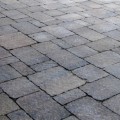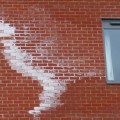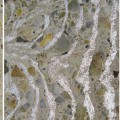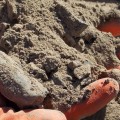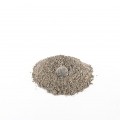
Comparing Deicers for Use on Masonry and Concrete
Sodium choride (rock salt, common salt, table salt)
Sodium chloride is the least expensive, most commonly used deicer. It is highly effective until at least 15 degrees Fahrenheit, but also has a strongly deleterious impact on our waterways, soil, plants, and it corrodes metal. It destroys masonry and concrete by allowing more water to soak into these structures before it refreezes, expanding within them. Discoloration can also be an issue when spreading rock salt across unsealed pavers. Because of all of these issues (especially the environmental issues), there is considerable interest in an economical and environmentally sustainable deicer that doesn’t wreak havoc on our infrastructure.
Magnesium Chloride
Magnesium chloride melts ice faster than rock salt, and is effective down to at least 5 degrees Fahrenheit. This is one of the most destructive deicers in regards to concrete due to the formation of noncohesive magnesium silicate hydrates produced by a reaction of dissolved magnesium with calcium silicate hydrates within the cement. In layman’s terms, it dissolves the “glue” holding the concrete together. Magnesium Chloride also causes metal to rust. While this deicer is damaging to plants and soil, it is not as drastic as the damage caused by rock salt.
Calcium Chloride
Calcium chloride also melts ice faster than rock salt. Calcium Chloride damages concrete more easily than rock salt, but not quite as easily as magnesium chloride. The chemical mechanism in which the concrete is damaged is not as well understood as what occurs with the use of magnesium chloride. Calcium chloride irritates skin.
Potassium Chloride
Potassium chloride is one of the most expensive deicing salts due to the rising cost of fertilizer prices throughout the world. Potassium chloride is effective to 12 degrees Fahrenheit, and it is relatively safe for vegetation. Like other deicing salts, potassium chloride can pollute waterways and is corrosive to metal. Unlike calcium chloride, potassium chloride will not irritate skin.
Calcium Magnesium Acetate (CMA)
CMA is effective to 20 degrees Fahrenheit, but may be able to turn ice to slush as far as 0 degrees Fahrenheit. Environmental damage is extremely low compared to other deicers, and CMA isn’t corrosive to metal. For concrete and masonry, CMA is the least destructive choice.
Light Gravel, Ashes, Cat Litter
Ash can melt ice during hours of intense sunlight, as it has low albedo (it is able to easily reflect energy from sunlight). Gravel or cat litter can supply necessary traction, though they do not melt ice. Adding these to your favorite deicer may make them more effective.
Shoveling
To minimize the number of freeze-thaw cycles, shoveling snow, slush, and ice is most effective. Consider the deicer as a tool that makes shoveling easier as opposed to an alternative method of ice-removal.


